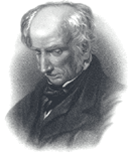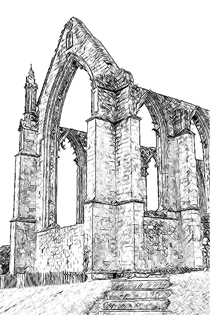One of the most rewarding pleasures of walking in the countryside is to follow in the footsteps of distinguished writers, and accordingly to see the scenery and environment through their eyes. Although the relationship between the Lake District and William Wordsworth has been well documented by walking book writers, his visits and walking tours to Yorkshire and particularly Craven have been largely overlooked. William Wordsworth is recognized as a founding father of romanticism in British Literature, it was his search for the picturesque and the sublime in nature that inspired his many walking tours and his early trips to Yorkshire.
One of the earliest known visits which Wordsworth made to Yorkshire was shortly after he returned to England from France in October 1793. William arrived in Yorkshire in February 1794 to stay with his sister Dorothy, who was living with her aunt, Elizabeth Rawson (formerly Threlkeld), at the Rawson family home Mill House, Triangle near Halifax. William stayed with his sister and the Rawsons at Mill House for six weeks before departing with her for the Lake District in early April. During his stay William and Dorothy explored the lovely Ryburn Valley with its riverside walks and superb woodlands. While it is appealing to speculate that William climbed the steep wooded hillside behind Mill House to Norland Moor, and the vista of the moors and Blackstone Edge beyond, there is little or no documented evidence of his short sojourn at Triangle.
William embarked on many excursions across the Pennines in the latter years of the 18th century and the early part of the 19th. Several of these journeys were made to the Hutchinson family and in particular to call on the Hutchinsons’ daughter Mary, whom William later married and took back to Grasmere to live with him and Dorothy. In December 1799 returning home on foot to Grasmere, after a visit to the Hutchinsons, who at that time were living on the family farm at Sockburn-on-Tees County Durham, William and Dorothy, visited Aysgarth Falls on the river Ure. On their journey through Wensleydale they stopped at the village of Askrigg and later explored Hardraw Force.
Continuing on their journey towards Grasmere they passed through Garsdale and on into Sedbergh. In a letter to Samuel Taylor Coleridge, written over Christmas 1799, four days after settling into their new home at Dove Cottage, William describing the journey home wrote “Well!, we rested in a tempting inn, close by Garsdale chapel, a lowly house of prayer in a charming little valley, here we stopped a quarter of an hour and then off to Sedbergh seven miles farther in an hour and thirty five minutes, the wind was still at our backs and the road delightful”.
In October 1802 when returning home to the lakes following his wedding to Mary Hutchinson at Brompton by Sawden near Scarborough, William, Dorothy, and his new bride Mary rested their horses at Kirbymoorside. Passing the time there, they sauntered around the local churchyard in the sunshine, reading the gravestones. The group stayed overnight in Helmsley where they visited the castle, the next day travelling on to Rievaulx Abbey and Duncombe Park. The party stopped to look at “a wild and bottomless tarn” Lake Gormire lying in a natural hollow beneath Whitestone Cliff, before spending the next night in Thirsk.
On this occasion the Wordsworths returned home to Grasmere along Wensleydale passing through some of my favourite walking country, Middleham, Leyburn and Aysgarth. The newlyweds broke their journey home through Wensleydale to once again visit Aysgarth Falls. Dorothy later wrote in her journal, “There was too much water in the river for the beauty of the falls”. Two years Earlier, in May 1800 on a walking tour to the Yorkshire Dales, William and his brother John visited Yordas Cave in Kingsdale, Gordale Scar and Malham Cove.
He returned to the area again in 1807 with his sister Dorothy to spend some time with the Marshall family in Kirkstall. During a stopover in Wharfedale on their way home, Dorothy and William visited Bolton Abbey and Barden Tower, from where they walked up the river Wharfe to Burnsall, then over the moors to revisit Malham Cove and Gordale Scar.
On returning home to Grasmere after this visit to Wharfedale in 1807 Wordsworth wrote The Force of Prayer, a poem which tells the Story of William de Romilly, the boy of Egremont who, as legend has it, died in a vain attempt to jump the Strid at Bolton Abbey. As he attempted to jump the gorge, with his dog on a lead, a leap which they had made on many previous occasions, the greyhound held back and pulled the boy into the water where he drowned. In the poem Wordsworth describes how the boy’s mother Lady Alice de Romilly, who owned the site of Bolton Priory, gave the land in memory of her son to the Augustinian canons who built the priory there.
It was this same visit to Wharfedale that inspired Wordsworth’s narrative poem The White Doe of Rylstone. He weaves two legends into the tapestry of the poem which gives an account of The Fate of the Nortons, a wealthy catholic family living at Rylstone Hall. In 1569 they were dispossessed of their lands (attained) and charged with treason after their part in a disastrous attempt to re-establish the catholic religion and free Mary Queen of Scots from her imprisonment. Thomas Norton and his nephew Christopher were executed for their part in the rising of the north, and a second nephew Francis was slain by Royalist soldiers.
The poem recounts the legend of the White Doe which made a weekly journey from Rylstone Hall, the home of the Norton family, across the fells to Bolton Abbey to visit the grave of the Norton’s only daughter the fictitious Emily. In life, the White Doe was her constant and devoted companion, following her everywhere. Emily was a regular visitor to Bolton Priory in the company of the Doe, Wordsworth wrote of her walks on Rylstone Fell and to Norton Tower, the ruins of which can still be seen high above the valley, on the edge of the fell.
Nor lacked she Reason's firmest power;
But with the White Doe at her side
Up would she climb to Norton Tower,
And thence look round her far and wide;
I have always valued the poetry of William Wordsworth; if as you walk the crest of a broad ridge in the Lake District or hike down a picturesque valley, you start to recite a piece of poetry inside your head. I cannot think of a better travel companion than Wordsworth.
Mick Melvin 2010